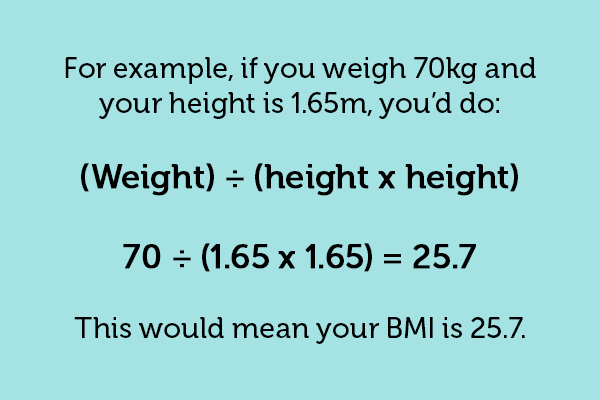15% off £25 or 20% off £35
Code:BASKET
How to calculate your BMI... and why it’s only part of the picture

Old-school magazines might suggest that body mass index (BMI) is the be-all and end-all. But is it always accurate? Find out how to measure your BMI – and if it’s made with you in mind
Summary
1What’s my BMI?
The easiest way is to use a BMI calculator, like the one on the NHS website. You’ll need to know your weight and your height...
2What your BMI means
Typically, a higher BMI increases your chance of developing health conditions like type 2 diabetes and heart disease...
3Ethnicity and BMI
The current BMI categories are mostly based on the white population and so may not accurately reflect people...
You’ve probably heard of BMI – and you might be wondering what yours is. But does it really have all the answers for your health?
BMI (Body Mass Index) is a tool used to calculate whether you’re considered a ‘healthy’ weight for your height. Your GP or some fitness apps might calculate it for you, or you can work it out at home.
People might calculate their BMI to help understand their weight range, or to track changes in their weight or health. Those over a certain BMI are considered at higher risk of conditions like diabetes and heart disease.1
While it can be useful to get an estimate of your ‘healthy’ weight, BMI has its limitations and shouldn’t be relied on completely.
So, how do you calculate your BMI... and how do you know if the answer’s useful for you?
What’s my BMI? How to calculate
The easiest way is to use a BMI calculator, like the one on the NHS website. You’ll need to know your weight and your height. Some calculators may ask you more questions (like your ethnicity) for a more accurate answer.

You shouldn’t use a BMI calculator if you or the person you’re using it for:1
- is under 18 (check our section on calculating children’s BMI)
- is pregnant
- has been diagnosed with an eating disorder or thinks they may have one
- has a condition that affects their height
You can work your BMI out yourself by squaring your height in metres, then dividing your weight in kilograms by that number. Only adults should use this method.
What your BMI means
OK – you've got your number.
Typically, a higher BMI increases your chance of developing health conditions like type 2 diabetes and heart disease.1 Typically, a BMI:1
- under 18.5 puts you in the ‘underweight’ category
- between 18.5 and 25 puts you in the ‘healthy weight’ category
- between 25 and 30 puts you in the ‘overweight’ category
- over 30 puts you in the ‘obese’ category
However, BMI can’t tell the difference between muscle and fat. So in some cases your BMI might class you as overweight even if your body fat is within the recommended range.1
Some tests may ask you to measure your waist to provide a more accurate idea of your body fat-muscle ratio.
BMI by age, sex and ethnicity
Plenty of factors can affect your BMI. Your age, sex and ethnic background might influence what’s considered a ‘healthy’ weight.
Ethnicity and BMI
The current BMI categories are mostly based on the white population and so may not accurately reflect people of different ethnicities.2
A 2021 Lancet study involving data from 1.4 million people in England found that some ethnic groups were at risk of diabetes at a lower BMI than the current recommendation of 30. For example, the study calculated cutoffs of 28.1 for Black people and 23.9 for South Asians.3
Despite a high BMI being linked to hypertension (high blood pressure) and diabetes in South Asians, BMI was a weak predictor of mortality.3
Sex and BMI
Men are often taller than women and tend to have a lower body fat percentage (influenced by sex hormones).4 So, even if they have the same BMI, their body fat percentages (and consequent risk of health conditions) may be completely different.
Even 'healthy' women may show a higher body fat percentage than men of the same fat-free weight due to increased fat tissue around the breasts and hips.
Age and BMI
The BMI calculations we mentioned above are for adults. You can measure a child’s BMI, but you must use a children’s BMI calculator to account for their differences in body proportions and the fact that they’re still growing.
But even among adults, all ages may not be accurately represented. People tend to become shorter as they age, which increases their BMI even if their weight doesn’t change.5 This can start as early as age 30.5
Menopause may also affect BMI. It's common to gain more weight around the midsection during and post-menopause. However, this isn’t considered in generic BMI calculations, potentially underestimating some menopausal women's true body fat distributions.6
Children and BMI
Rather than by a number, children’s BMI is measured in centiles. This number ranges from one to 99 and represents how a child compares to the national average for their sex.
For example, a girl in the 60th centile has a BMI higher than 60 out of 100 girls her age. The 50th centile would be considered completely average.
The ‘healthy’ range is much bigger for children, as they haven’t finished growing. They might grow disproportionately (i.e. having a growth spurt in height before their weight ‘fills out’) and they tend to have lower muscle mass than adults.

For children, a BMI:7
- below the 2nd centile puts them in the ‘underweight’ category
- between the 2nd and 90th centile puts them in the ‘healthy weight’ category
- above the 90th centile puts them in the ‘overweight’ category
If you’re worried about your child’s BMI result or their eating habits, speak to their GP.7
Thinking outside the BMI box: what else should you consider?
So, BMI can be useful – but it’s not the full picture. What else is there to think about?
Even if you’re a healthy weight, plenty of other factors can increase your risk of health problems.
And it doesn’t necessarily mean you’re happy!
When thinking about your overall health, consider:
- whether you drink alcohol, and how much
- whether you smoke
- how much you move your body – the NHS recommends adults get 150 minutes of moderate activity or 75 minutes of vigorous activity per week 8
- how much sleep you get
- how much water you drink
- whether you generally feel relaxed and content
- how well you can go about your daily activities
- whether your meals are regular, varied and balanced
- the amount of time you spend thinking about your weight or your diet
The final say
Despite its limitations, BMI can be useful. It might help you identify your risk of certain conditions like diabetes and heart disease or may help you understand whether you should check things over with your GP.
If you’ve been advised to try and manage your weight, stay safe and keep it slow. Check out our guides on how to gain weight and muscle safely, or learn how much protein you should be getting with our personalised protein calculator.
Disclaimer - This article provides informational advice and is not a substitute for medical care. Curated by experts for accuracy, we take great care to ensure the information is up-to-date and relevant. However, you should always consult your GP or healthcare professional before using supplements or alternative products, particularly if you have medical conditions or are under supervision
1. NHS. Calculate your body mass index (BMI) for adults [Internet]. NHS [reviewed 2023 Nov 28; cited 2025 Aug 4]. Available from: https://www.nhs.uk/health-assessment-tools/calculate-your-body-mass-index/calculate-bmi-for-adults
2. American College of Cardiology. More Than Skin Color: Ethnicity-Specific BMI Cutoffs For Obesity Based on Type 2 Diabetes Risk in England [Internet]. American College of Cardiology [reviewed 2021 Oct 18; cited 2025 Aug 4]. Available from: https://www.acc.org/Latest-in-Cardiology/Articles/2021/10/18/15/35/More-Than-Skin-Color
3. Caleyachetty R et al. Ethnicity-specific BMI cutoffs for obesity based on type 2 diabetes risk in England: a population-based cohort study/ The Lancet [Internet]. 2021 Jul [cited 2025 Aug 4]; 9(7): 419-26. Available from: https://www.thelancet.com/journals/landia/article/PIIS2213-8587(21)00088-7/fulltext
4. Ethun K. Chapter 9 - Sex and Gender Differences in Body Composition, Lipid Metabolism, and Glucose Regulation. Sex Differences in Physiology [Internet]. 2016, 145-65. Available from: https://www.sciencedirect.com/science/article/abs/pii/B9780128023884000094
5. Holt PR, Altayar O, Alpers DH. Height with Age Affects Body Mass Index (BMI) Assessment of Chronic Disease Risk. Nutrients [Internet]. 2023 Nov 6 [cited 2025 Aug 4]; 15(21): 4694. Available from: https://pmc.ncbi.nlm.nih.gov/articles/PMC10649148/
6. Banack HR, Wactawski-Wende J, Hovey KM, Stokes A. Is BMI a valid measure of obesity in post-menopausal women? Menopause [Internet]. 2018 Mar [cited 2025 Aug 4]; 25(3): 307-13. Available from: https://pmc.ncbi.nlm.nih.gov/articles/PMC5821529/
7. NHS. Calculate body mass index (BMI) for children and teenagers [Internet]. NHS [reviewed 2024 Sep 9; cited 2025 Aug 4]. Available from: https://www.nhs.uk/health-assessment-tools/calculate-your-body-mass-index/calculate-bmi-for-children-teenagers
8. NHS. Physical activity guidelines for adults aged 19 to 64 [Internet]. NHS [reviewed 2024 May 27; cited 2025 Aug 4]. Available from: https://www.nhs.uk/live-well/exercise/physical-activity-guidelines-for-adults-aged-19-to-64/












